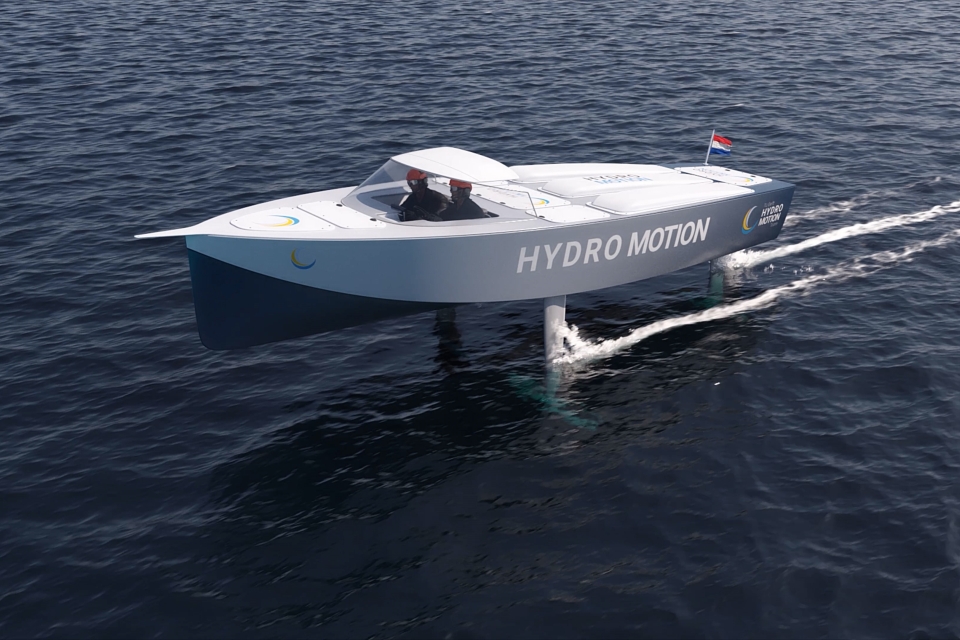In 2023, the TU Delft Hydro Motion Team set itself a mission: to sail a foiling hydrogen-powered boat from the Netherlands to the United Kingdom. At the end of December, the team revealed their 2024 design.
With the boat, the Hydro Motion Team wants to show the maritime industry a path towards a sustainable future. The students want to initiate change by highlighting the crucial role of legislation, the integration of hydrogen-powered vessels, and the expansion of necessary infrastructure.
Also read: VIDEO: TU Delft Hydro Motion Team reveals new boat
2024 boat design
Since August, the team has been working on the design of the 2024 boat. What first catches the eye, is that the new boat is bigger than the one from last year. It now measures 8 metres in length (2023: 7 metres) and is 2.65 metres wide (2.2 metres in 2023). This was done to increase stability, which is needed to tackle the rough conditions of the North Sea.
Both the front and rear of the boat are quite narrow to lower resistance through the water and increase efficiency. The middle section is noticeably wider, once again to improve stability. The boat also has a sharp bow to cut through waves.
The boat will also feature a chine, which helps to smoothly transition from regular sailing to “flying” above the water. In addition, it helps to keep the boat stable during lift-off and decreases spray.
Also read: [VIDEO] TU Delft students present world’s first ‘flying’ hydrogen boat
Lightweight with foils
To allow the boat to “fly” over the water, it is equipped with foils that lift the boat from the water once it reaches a speed of 28 km/h. For the foils to be able to do that, the boat needs to be as light as possible. That is why the hull is made from carbon fibre.
To make the hull strong in every direction, the team uses multiple layers of carbon fibre with fibres oriented in different directions. They are held together by a resin. To further enhance strength, a thick layer of foam is placed in between the layers of carbon fibre.
The boat is equipped with three struts with wings attached, the so-called foils. Once the foils lift the boat out of the water, it loses the stability provided by the hull. To keep the boat steady in the rough conditions of the North Sea, it is equipped with active height control. This is achieved by using tilting foils that can individually adjust their angle to keep the boat steady.
The struts are also used to transport seawater to the hull, where it is used as a coolant for the systems on board.
Powered by hydrogen
The boat has three big cylindrical tanks of hydrogen that are over 2 metres long. Together, they contain about 25 kg of hydrogen. The hydrogen is stored at a pressure of 350 bar.
The hydrogen is delivered to a fuel cell, which converts it into electrictity for the boat. The boat is also equipped with 224 small batteries divided over seven modules. These supply extra power when needed, but can also be used to power all electronics on board when the fuel cell is not yet switched on, such as in port.
Watch the video of the presentation of the new boat below. The reveal and discussion of the design starts at approximately 24:15.
Details of the 2024 hydrogen boat
Length: 8.00 metres
Width: 2.65 metres
Take-off speed: 28 km/h
Cruising speed: 40 km/h
Fuel cell power: 40 kW
Weight: 1800 kg
Hydrogen tanks: 3 hydrogen tanks of 8.4 kg H2 each
Foils: The foils create upward lift. The strut length is 2.07 metres, the wing span is up to 1.7 metres
Also read: TU Delft launches Wind Assisted Ship Propulsion Research Programme








